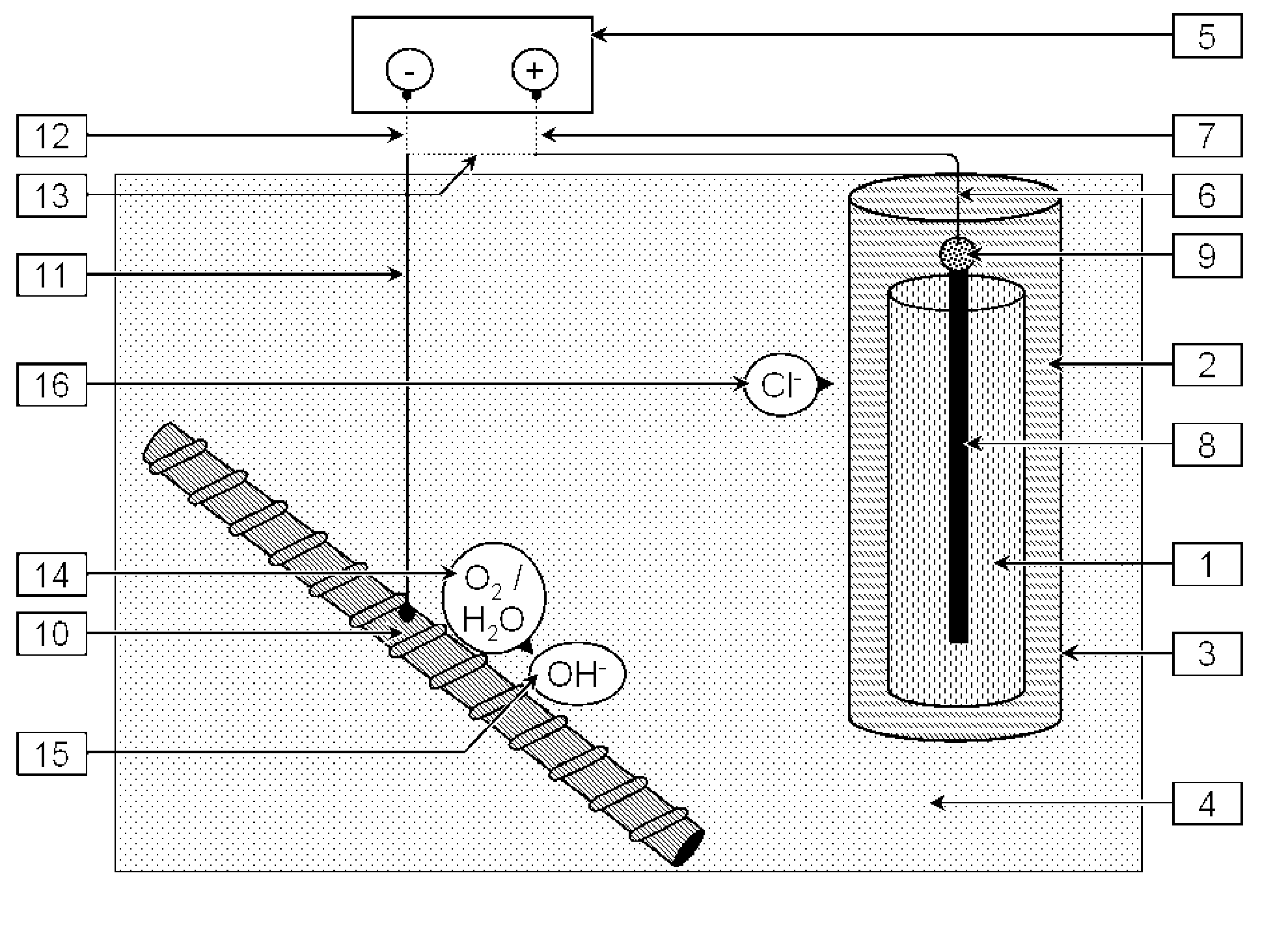Treatment process for concrete
a technology of electrochemical treatment and concrete, which is applied in the direction of walls, coverings/linings, constructions, etc., can solve the problems of deterring the use of embedded sacrificial anodes, affecting the service life of sacrificial anodes, so as to achieve less acid, less driving voltage, and less gas
- Summary
- Abstract
- Description
- Claims
- Application Information
AI Technical Summary
Benefits of technology
Problems solved by technology
Method used
Image
Examples
example 1
[0092]An anode 15 mm in diameter and 100 mm long comprising a bar of the aluminium alloy known as US Navy specification MIL-A-24779(SH) that was cast around a titanium wire to facilitate the electrical connection to the aluminium was embedded in a lime putty in a 25 mm diameter by 130 mm deep hole in a concrete block. The basic arrangement is shown in FIG. 1. The concrete block measuring 380 by 270 by 220 mm was made using graded all-in-one 20 mm aggregate and ordinary Portland cement in the ratio 8:1. The water to cement ratio was 0.6 and 4% chloride ion by weight of cement was added to the mix by dissolving sodium chloride in the mix water. A sheet of steel with a surface area of 0.125 m2 was included in the concrete block. The lime putty was produced by slaking and maturing quicklime and was sourced from a manufacturer of lime putty and lime mortars. The hole in the concrete block containing the lime putty and the anode was left open to the air. The concrete block was stored in a...
example 2
[0096]Twenty five aluminium alloy anodes 15 mm in diameter and 100 mm long described in example 1 were embedded in a concrete column containing steel reinforcement with a steel surface area of 3.2 m2. The column was sheltered from rain and moisture and was very dry, but was within sight of the sea and exposed to airborne chloride contamination. The anodes were installed by drilling 25 mm holes 180 mm into the concrete, partially filling the holes with a mixture of lime putty and 10% polystyrene and finally pressing the anodes into the putty until they were fully embedded in the putty. The anodes were evenly distributed over the column and were located between the reinforcing steel bars.
[0097]The anodes were connected to the positive terminal of a 12 Volt DC power supply and the steel was connected to the negative terminal for a period of 8 days during which time a charge of 67 kC / m2 was delivered to the steel surface. The current density delivered off the anodes during this period i...
PUM
| Property | Measurement | Unit |
|---|---|---|
| current density | aaaaa | aaaaa |
| current density | aaaaa | aaaaa |
| time | aaaaa | aaaaa |
Abstract
Description
Claims
Application Information
 Login to View More
Login to View More - R&D
- Intellectual Property
- Life Sciences
- Materials
- Tech Scout
- Unparalleled Data Quality
- Higher Quality Content
- 60% Fewer Hallucinations
Browse by: Latest US Patents, China's latest patents, Technical Efficacy Thesaurus, Application Domain, Technology Topic, Popular Technical Reports.
© 2025 PatSnap. All rights reserved.Legal|Privacy policy|Modern Slavery Act Transparency Statement|Sitemap|About US| Contact US: help@patsnap.com



